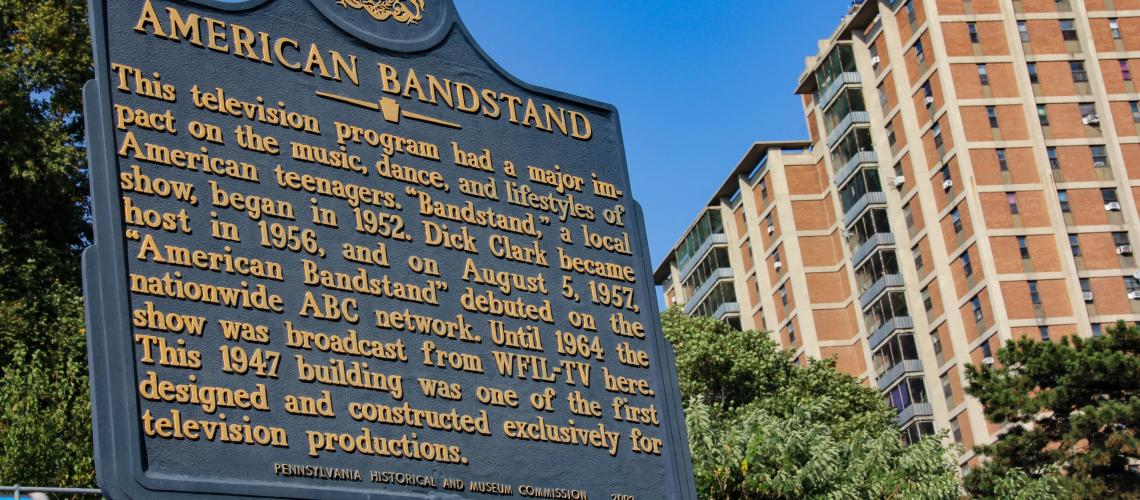This historical marker recalls Dick Clark’s American Bandstand, which was broadcast from West Philadelphia from 1957 to 1964. The marker stands opposite 4548 Market Street (not shown here), which once housed WFIL-TVand its Studio B, the original home of American Bandstand.
Dick Clark’s American Bandstand, a popular though controversial TV program targeted toward teenage consumers, marked Philadelphia as the national epicenter of pop music during its seven-year run at ABC’s affiliated WFIL-TV at 4548 Market St.
ABC-affiliate WFIL-TV at 4548 Market St. broadcast Dick Clark’s American Bandstand to a national audience of teenage consumers from 1957 to 1964. American Bandstand built a national youth culture around the pop music records Clark played on the show and the commercial products his sponsors targeted to this $9 billion consumer market. Clark inherited WFIL’s local television show Bandstand (1952-56) from the deejay Bob Horn, who proved that teenagers liked watching their peers dance. Clark revamped Horn’s show for national broadcast by ABC. While Clark opened American Bandstand’s stage to black R&B and rock ‘n’ roll performers, he and his producers segregated the studio’s dance floor and white teenagers adapted black dances for white audiences.
Stories in this Collection
 Dick Clark’s American Bandstand was the offspring of deejay Bob Horn’s Bandstand, which WFIL-TV broadcast daily from 1952-56 from a WFIL studio at 4548 Market St. The program’s signature features were Philadelphia teens dancing to popular music and the portly Horn interviewing musical guests who lip-synced their latest hits on the show. When Horn’s personal indiscretions led to his ouster from Bandstand in 1956, he was replaced by the more youthful, slimmer, “squeaky clean” Dick Clark. |
 In July 1956, Dick Clark, a commercial pitchman and deejay with an unsullied reputation, inherited WFIL-TV’s Bandstand from scandal-tainted Bob Horn and revamped it for a national audience of teenage consumers as ABC’s American Bandstand, which first aired in August 1957. Clark’s daily afternoon program pioneered in musical television by showcasing a range of black and white pop music performers, including R&B, rock ‘n’ roll, and country. Yet, as the third and fourth stories in this collection show, there was a downside to American Bandstand’s Philadelphia years. |
The longstanding popular belief about American Bandstand, promoted by Dick Clark in the later years of his career, is that the Philadelphia version of the show racially integrated the Studio B dancefloor and bleachers. That belief is persuasively challenged by recent scholarship: American Bandstand “The Philadelphia Way” not only excluded black teens from the show but also represented black dances as having originated on the show with its white dancers. Consequently, black teens were in effect erased from the national youth culture that formed around American Bandstand. |
 At least three factors are important to note regarding the last three years of American Bandstand in West Philadelphia: the 1960 “payola” scandal, the reality behind the show’s happy faces, and developments in the pop music industry that affected the show and compelled its relocation in 1964 to Los Angeles in a reduced version. |
